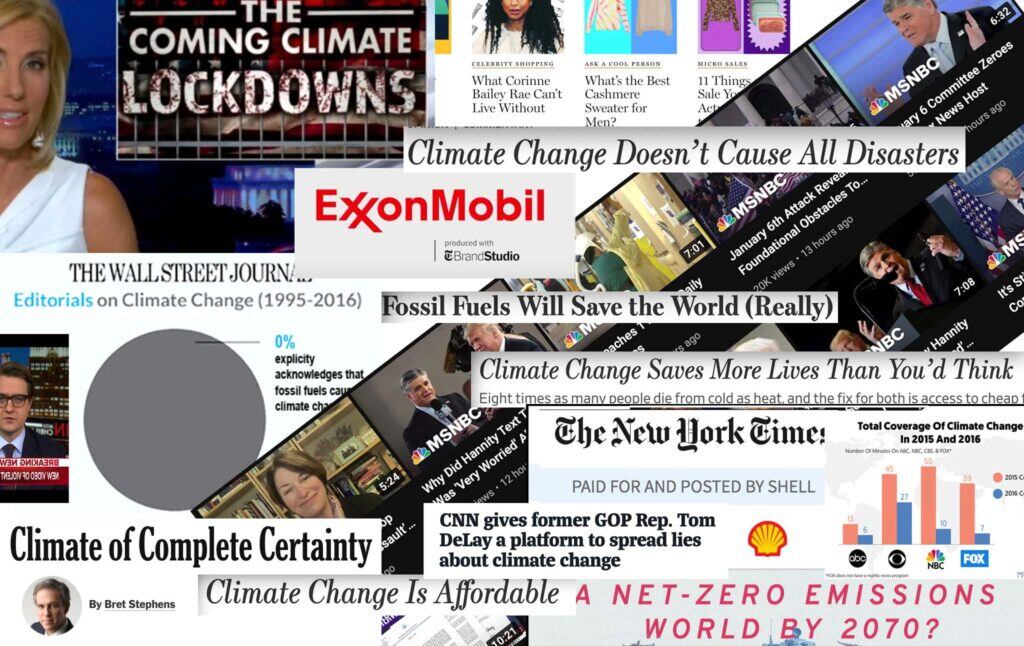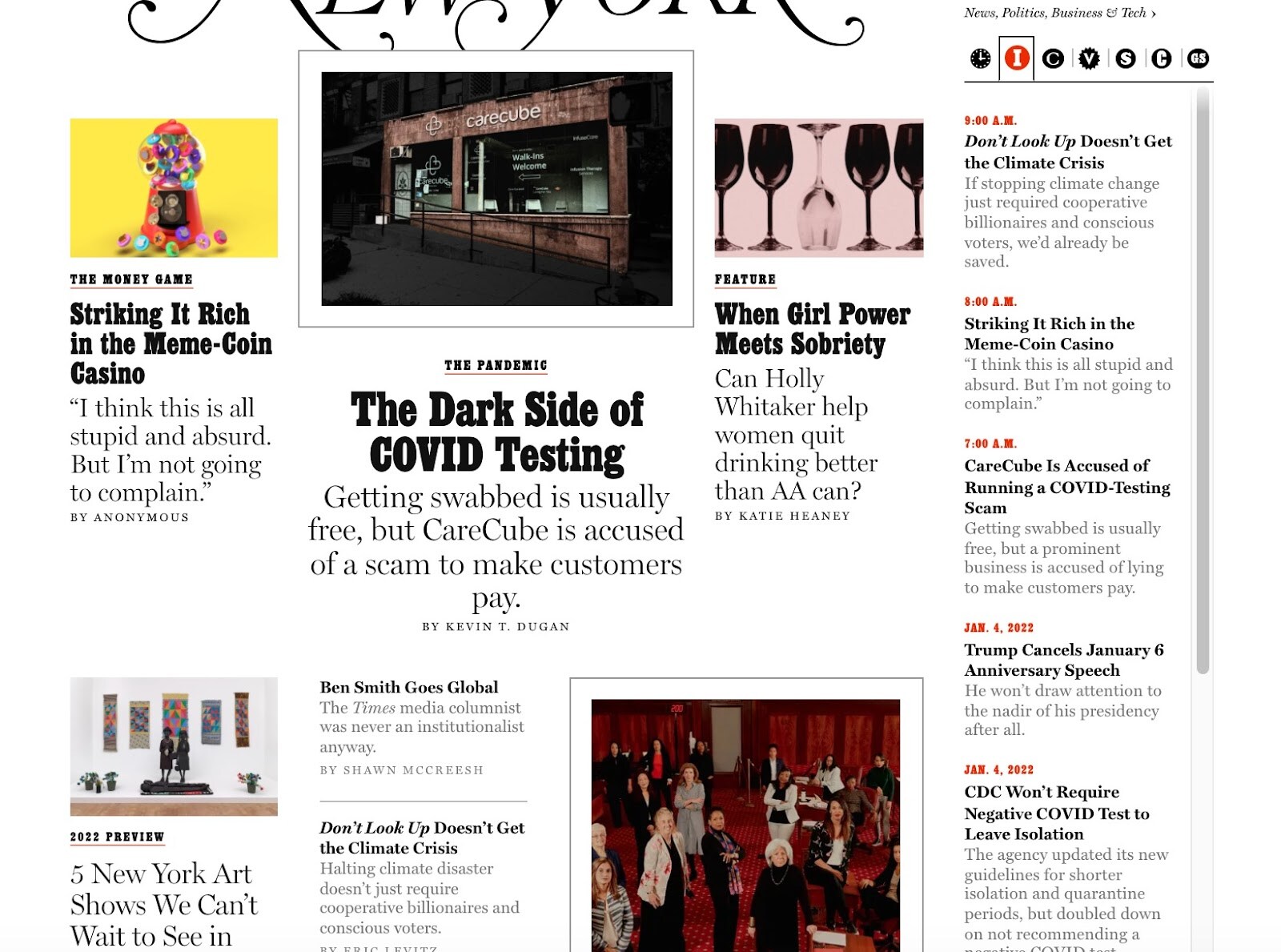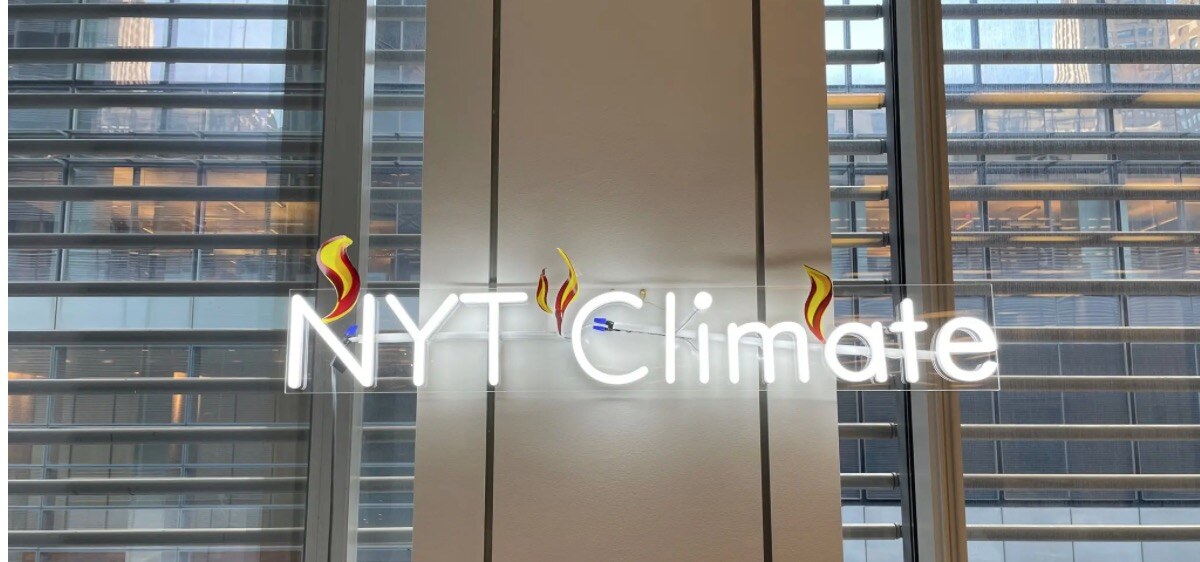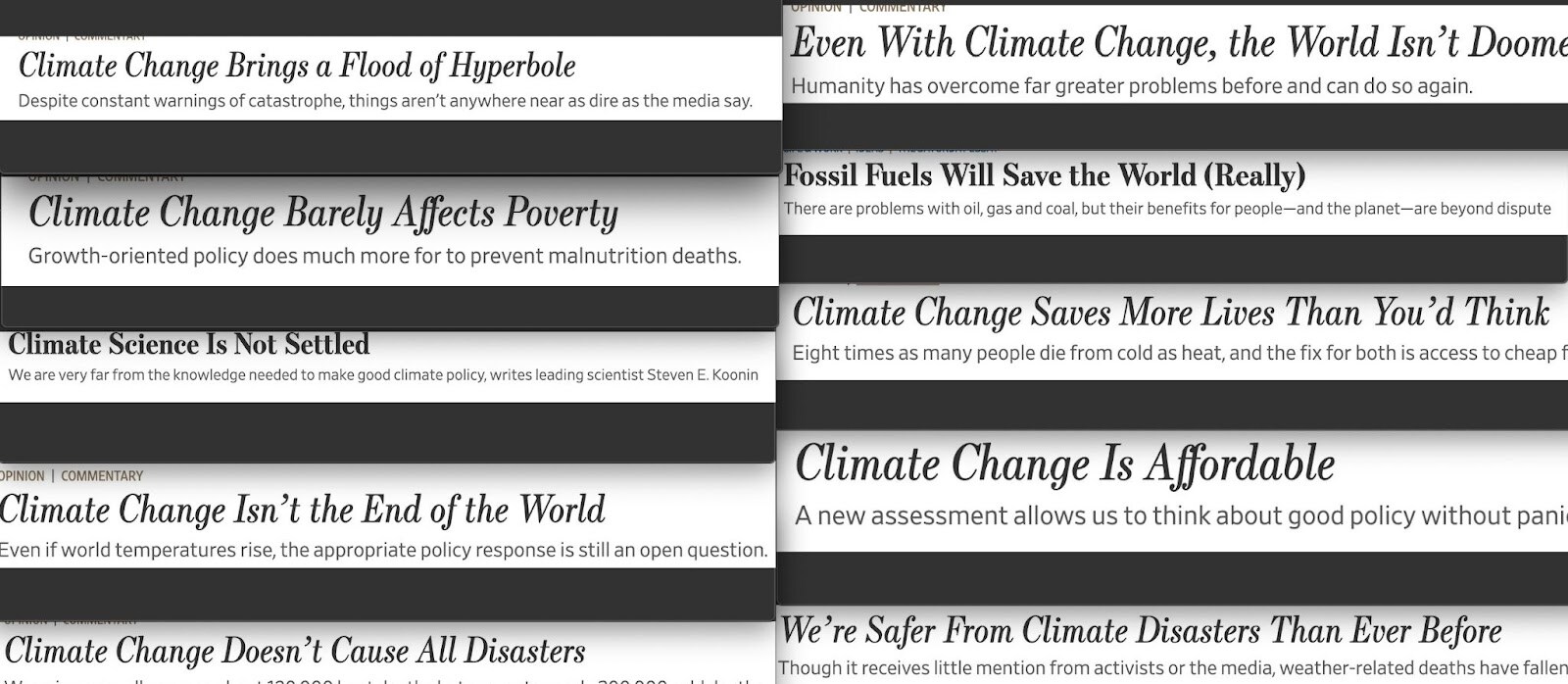
The Media’s Climate Coverage Is Indefensible
Members of the press think they’re doing a good job reporting on climate change. They need to read their own publications.
The most popular film on Netflix right now, Don’t Look Up (which I recently reviewed), is a satire and allegory about the lack of a serious response to the climate crisis, in which a deadly comet is hurtling toward Earth but scientists cannot convince anyone to stop it. One of the film’s chief targets is the American news media, which is portrayed as caring more about vapid celebrity news than an impending catastrophe that implicates the future of humankind.
But is this critique fair? Eric Levitz of New York magazine argues that the Don’t Look Up view of the news media is false. Levitz criticizes the film’s focus on billionaires, the fossil fuel industry, political elites, and the media as the chief culprits behind climate inaction. A big part of the problem, he says, is that middle-class Americans are unwilling to accept the sacrifices they would need to make to address the climate crisis.
Setting aside the question of whether the Don’t Look Up narrative insufficiently blames the American middle class, I’d like to focus here on the important question of whether contemporary media coverage of climate change is adequate. If Levitz is right, then there is little need for journalists to reform their approach. They can keep doing what they’re doing, because they’re not the source of the problem. Levitz argues, citing examples from his own magazine and the New York Times, that in fact the press have been taking climate very seriously:
[Don’t Look Up director Adam] McKay’s conception of the news media’s role … seems slightly deranged. In one recent interview, he suggested that careerism prevents reporters from conveying the alarming truths of climate change, telling Space.com, “It takes a lot of guts to raise your hand at that newspaper meeting and go, ‘Why don’t we have a giant headline that says, ‘Oh my God, we’re all going to die!’” But I can assure you this takes no guts at all (assuming McKay was speaking figuratively). This magazine did a weeklong climate-change series last year. And we’re doing it again later this month. The New York Times publishes large alarming packages on climate change every few weeks. Generally speaking, the left-of-center college graduates who staff mainstream-media outlets care more about climate change than the average American. And the subject’s prominence in major media reflects this ideological commitment more than it does any business imperative; as McKay’s film suggests, climate change is not surefire clickbait.
The argument here is that big publications like the New York Times and New York magazine actually defy their industry’s financial incentives to carry out their duty to inform the public. Climate change is, in the words of MSNBC anchor Chris Hayes, a “ratings killer,” but it’s obviously critically important, so these publications have shown a serious “ideological commitment” by covering it.1
Let’s evaluate whether New York magazine does, in fact, as Levitz says, carry out its duty to keep the public well-informed about the climate crisis. We’ll have a look at the magazine’s homepage and play a little game called “Spot The Climate Coverage”

Okay, so we have Levitz’s piece criticizing Don’t Look Up. We also have some COVID-19 coverage. Then Striking It Rich In The Meme-Coin Casino. 5 New York Art Shows We Can’t Wait To See. Ben Smith Goes Global. When Girl Power Meets Sobriety. Trump Cancels Jan. 6th Anniversary Scheme. Other parts of the front page don’t seem much more promising:

Ooh, the 25 Best-Smelling, Bubbliest, Most Soothing Bath Products! To avoid screenshotting the whole thing, I’ll list every headline. Some repeat on the page, and these are in no particular order: How NBC’s Susan Rovner Gets It Done. Madame Clairevoyant: Horoscopes For The Week of Jan 3. Are The Grammys Still Happening? 2022: Choose Your Own Hellscape. The Thrill of a Bachelor Contestant Saying ‘I Hate Him.’ 11 Things On Sale You’ll Actually Want To Buy: From Briogeo to Lisa Says Gah. The Biggest Problems Facing New York’s Restaurants Right Now. How The Jan 6th Insurrection Birthed A New Right. For The First Time, New York City Has A Majority-Women City Council. Drivers Were Stranded On I-95 For Almost A Full Day. America Does Something Right For Once.2 The Political Life of Dr. Oz. Seriously, Upgrade Your Face Mask. What’s The Difference Between KN95 and KF94 Masks? What Are The Best Disposable Face Masks? Gina. Rosanne. Guy.: What Three Jan 6th Insurrectionists Wanted—And What They Lost. Rikers: The Obituaries. 66 Of The Best New (Or Newly Relevant) Places To Eat. The 55 Best Lines From 2021’s Grub Street Diets. The Absolute Best: Steakhouses, Square Pizza, Bagels, Pho, Hot Dogs, Doughnuts, Fish Tacos, Italian. CDC Won’t Require Negative COVID Test To Leave Isolation. Ron DeSantis’ Vaccination Status Is Now A State Secret. At Least The Snacks Were Fantastic In 2021. Oh No, Adam Neumann Wants To Be A Landlord Again. A $520K East Village One-Bedroom and an Inwood Three Bedroom Duplex. Venice Bridge Will Be De-Calatrava’d To Stop Pedestrians From Face-Planting. Henrietta Hudson’s Bartenders Can Serve You Drinks. Maris Kreizman And Josh Gondelman’s Favorite Spots In Boerum Hill. Murray Moss Wants To Live In The Harvard Club. Gub Street’s Dining Resolutions For 2022 And Beyond. Adam Platt’s 12 Best Restaurants of 2021. At Balthazar, COVID Cases Are Up And Staff Morale Is Down. What You Need To Know About Double-Masking. 27 Of The Very Best Planners. What Corinne Bailey Rae Can’t Live Without. What’s The Best Cashmere Sweater For Men? Chris Evans Steps Into His Tap Shoes As Gene Kelly In Upcoming Film. Oh Crap! A New Uncharted CClip Just Dropped. Rapper Pooh Shiesty Pleads Guilty To Firearms Conspiracy Charge. Everything You Wanted To Know About This Year’s Golden Globes. Jodie Turner-Smith Brought Her New Motherhood to Anne Boleyn. 41 Movies We Can’t Wait To See In 2022.
What can we say about all this? Well, I personally find it quite amusing that Levitz waves away Don’t Look Up’s media critique as “somewhat deranged.” That critique, remember, is that the news media prefers fluffy celebrity gossip stories to serious matters of public interest that affect human lives. New York magazine has exactly one story about the climate crisis on its homepage right now, and it is Levtiz’s own criticism of Don’t Look Up. Its pandemic coverage, as we can see, is slightly better, although paying attention to the pandemic is unavoidable. But on the whole, we can see that New York magazine is precisely like the vapid morning show hosted by Cate Blanchett and Tyler Perry in Don’t Look Up. Maybe it will occasionally publish on a topic that affects human lives. But food, pop culture, and celebrity stories outweigh substantive reporting by about 50-1.
When I pointed this out to Levitz, he did not seem to think it undercut his belief that New York does a good job drawing public attention to climate change:
“Yes…today, our general interest magazine, which has one straight news vertical staffed by a small team of online writers, has one 4,000-word piece on the climate crisis on the front page.”
Now, personally, I do not think this is much of a defense. The justification for not covering the news is that the magazine does not cover the news. It is “general interest,” i.e., mostly about famous people and restaurants. But this does not do anything to undercut the criticism that the media is too focused on famous people and restaurants to get the public the information necessary to take important action on climate. (The 4,000 word piece he mentions is his own review attacking Don’t Look Up.) Levitz said climate coverage has “prominence in major media,” citing his own publication as an example. Clearly it doesn’t, even if that lack of coverage is blamed on the public’s general interest in finding the best fish tacos in New York City.
Alright, New York magazine is vapid. But what about the New York Times? The publication has a whole climate desk, with dozens of journalists on the beat. They produce lots of in-depth reporting on climate catastrophe. (This is a recent development. Prior to 2017, the Times strived for “balance,” in its climate reporting, saying it was “always going to look for the other side of the story,” i.e., making sure to give space to fossil fuel propaganda side-by-side with scientific fact.)
They even have a custom neon sign in their office that says NYT Climate, with whimsical little flames popping out of it to represent the fact that the planet is burning. What more do you want?

But the New York Times is not off the hook for bad climate coverage. Just this week, I read an article on the aftermath of the horrific recent Colorado wildfires, which featured a surreal apocalyptic photograph of a neighborhood that had completely burned down and was now covered with snow. “Colorado Residents Ponder The Road Ahead After Wildfires,” it read. Not once did the article mention the role of climate change in causing the wildfires. The paper’s initial report on the wildfires does contain a sentence about climate change, but in that piece, the residents who lost their homes bring up climate change more than the journalist writing the piece. Even a piece on the bizarre fact that extreme snow immediately followed extreme fire in Colorado barely mentions climate change, beyond mentioning offhand that we are in a “new world” where there is a “warmer, drier climate in the mountain west.” A piece on the causes of the fire mentions briefly that “a severe multiyear drought nurtured the brittle-dry conditions that allowed the fire to sweep through residential areas,” but does not talk about the deeper root causes of this dryness, and is instead about how a Christian fundamentalist group is being investigated as possibly being “the cause” of the fire.
In fact, the New York Times has the best climate coverage of any media outlet, and it’s still woefully inadequate. A 2019 Berkeley study of media coverage of climate change found that the basic facts about it were barely mentioned in the news. When it is mentioned, the fact that it is human-caused is often left out, and it is treated almost as an unavoidable fact of existence. (This is absolutely the case in some Times coverage of the Colorado fires.) When the fact that it is human-caused is mentioned, the fact that it is caused by the burning of fossil fuels is not mentioned. Hardly ever mentioned is the fact that we can do something to halt the phenomenon from worsening, and that we need to if we’re going to avert human suffering.

The Times can point to lots of excellent work it has put out on the climate crisis. But it also engages in forms of “soft denial” by leaving out discussions of the cause of the problem when covering the consequences. (Not to mention hiring a columnist who uses his platform to encourage people to cast more doubt on climate science rather than giving that column to, say, a climate scientist.) Furthermore, while there are plenty of individual reports on the climate crisis, the paper’s emphasis is not the kind that one would present if one believed the facts presented. I did the same exercise with the New York Times homepage as I did with the New York homepage, and while the Times devotes far less space to bubble baths and square pizza, the Fitness and Food sections are far more prominent than the Climate & Environment section, which is hard to find because it is located at the bottom of the page. (The sections of the paper in the top menu bar include Style, Travel, and Health but not Environment.) Out of the first 50 stories on the page, the only one about climate change is called “This Vast Wildfire Lab Is Helping Foresters Prepare for a Hotter Planet.” Despite the title, it only mentions the role of climate change in worsening wildfires in a single sentence. Instead, it is about how better forest management can help reduce the intensity and spread of wildfires. This story may be true, but shifting the focus from climate change to forest management is also a tactic of the right, who (when they admit it’s happening at all) want us to talk about how we “adapt” to climate change rather than what’s causing it and how to slow it. By acknowledging the role of climate change in a sentence, and then spending the whole article talking about ways that the out-of-control wildfires might be tamed through human intervention, the article reinforces the idea that climate change is an inevitability. Once again, a piece of “climate coverage” omits the facts that the changes are caused by humans, that fossil fuels are responsible, and that we need to stop burning them.
Near the bottom of the Times front page, about 70 stories in, there is one more piece of climate-related writing, which appears under the headline “Have Wildfires Ruined California’s Magic?” or “This Isn’t The California I Married.” It is a first-person account by a wealthy Californian of how sad it is to see the magical state she once fell in love with consumed by ecological catastrophes. It certainly confronts the consequences of climate change head-on, and even mentions why they’re happening. But it also displays a sense of lament and inevitability: “We can’t fix California’s wildfire problem with a big idea. We can only settle into the trans-apocalypse and work for the best future, the best present.” It counsels against “nihilism” and says that certain things can be done, but it doesn’t discuss the fact that we know what we have to do. When the American mainstream press does cover climate change, it often does so with a kind of apocalyptic pessimism and resignation that is almost as damaging in its effects as outright climate denialism. (E.g. Jonathan Franzen’s New Yorker essay arguing that serious action is hopeless, or David Wallace-Wells’ terrifying The Uninhabitable Earth, first published in—where else?—New York magazine.)
Writing about climate change in a way that makes people feel scared and hopeless, like they are going to die in a wildfire whether they like it or not, is, in my opinion, part of why climate coverage is such a “ratings killer.” My suspicion is not that nobody wants to confront the subject of climate change—Don’t Look Up faces the matter head-on, and is hugely popular—but that if discussion of it just feels disempowering and depressing, there is no reason for anyone to read about it. Here at Current Affairs, two of our most popular recent articles have been on climate change, but the underlying message has been about taking action rather than merely forecasting the inevitable apocalypse.) I do not think it is helpful to tell anyone to “settle into the trans-apocalypse.” No! Join the Sunrise Movement and throw political leaders who refuse to act on climate out of office.
All of this is just about the New York Times’ coverage of climate. But the paper does something even more insidious as well: it literally lets fossil fuel companies write paid content for the paper about climate change. This is an article about climate change written by Shell that appears on the New York Times website as a paid post. They literally let the industry responsible for the problem bribe the paper into publishing industry-written propaganda. It’s completely unconscionable. The company’s “T Brand Studio” has even made ads for fossil fuel companies:

Yet the New York Times has declined repeated calls to stop taking dirty fossil fuel industry money. As Genevieve Guenther of End Climate Silence notes, the hypocrisy is galling:
“On one hand, they’re trying to seem like part of the reality-based community who acknowledges the climate crisis and wants to solve it. On the other, they’re doing everything they can to keep the fossil fuel economy going because it is one of the sources of their own power and they believe in it.”
Some publications and ad agencies have actually stopped working with fossil fuel companies. The New York Times has even covered the phenomenon of organizations severing their ties to the industry, but defended its decision not to join them:
Several publications have limited or stopped accepting fossil fuel ads, including the British Medical Journal, The Guardian, and the Swedish publications Dagens Nyheter and Dagens ETC. The New York Times said in a statement that it did not allow oil and gas companies to sponsor its climate newsletter, its climate summit or its podcast “The Daily.” It still publishes paid posts from companies such as Exxon. In a statement, The Times said that “advertising helps support our newsroom, which covers the issue and impacts of climate change more than any other in the U.S.”
(In fact, every time a new corporation announces it is rejecting fossil fuel money, the Times reminds readers that it doesn’t let fossil fuel companies “sponsor its climate newsletter.”)
As bad as the New York Times is, it is not the worst. The Wall Street Journal, with an even higher circulation, publishes outright climate denialism in its op-ed pages. (Its news stories, which are under a greater obligation to tell the truth so that corporate executives can make sound investments, are not as bad.) The editorials the Journal has run seem to be part of an ongoing in-house competition to see who can come up with the barmiest possible take on global warming:

Fossil fuels will save the world! Climate change saves lives! We’re safer than ever! Okay, even if it causes disasters, it doesn’t cause all disasters! The Journal’s playbook on climate is a repetition of the ones it used to cast doubts on the harms of tobacco use and acid rain in previous generations. The same themes come up over and over: The science is still unsettled. Okay, the science isn’t unsettled, but we don’t know what to do about it, or whatever is being proposed is too costly, and will hurt GDP more than climate change itself. All we need to do is let the market “adapt” to the problem. It’s not hard to see why a pro-business newspaper pushes this line. Dealing with climate change adequately necessarily threatens the free market philosophy. As Kate Aronoff writes in Overheated: How Capitalism Broke the Planet—And How We Fight Back (the single best book on the climate crisis and what we need to do about it, which everyone should have a copy of), “bringing down emissions means declaring trillions of dollars worth of fossil fuel assets—all those reserves that can’t be safely burned—worthless. If carried out, this would represent the single largest evaporation of private wealth since the Emancipation Proclamation.” No wonder the Wall Street Journal is desperate to convince us we should just let climate change rip.
The right-wing media is very powerful in this country. Fox News, who treat climate change as a phony threat invented by liberals to justify authoritarianism, and bring on fake “environmentalists” to tell lies, has the largest audience of all the cable networks. But even those “liberal” networks are useless in informing the public on climate change. Look through the latest MSNBC videos and see how much good climate reporting there is, and compare it with the amount of reporting on the (admittedly disturbing) Jan. 6th Capitol riot. We know from Hayes that the company thinks climate is a “ratings killer,” and we can see that in practice that means going near the subject as little as possible. (CNN, for its part, runs far more minutes of fossil fuel industry ads than news about climate change, according to a Media Matters investigation.)
I shouldn’t need to tell you that we are at an absolutely critical point for climate action, and that we urgently need a popular uprising to pressure political leaders into action. (Again, see Aronoff’s book for a clear account of what can be done.) But without a concerted effort by you, me, and the American news media, the issue will disappear from political discourse even as the crises become worse and more frequent. The Wall Street Journal says that around the world, politicians will aim to talk “as little about climate as possible” in 2022 and are planning to scale back their ambitions to deal with the problem, because they are costly and unpopular. (The Journal, of course, thinks this is a good thing, and describes this new wave of inaction as “climate realism.”) We cannot let this happen.
Journalists need to accept that their profession has failed us completely. Assuming that many journalists think as New York’s Levitz does, they probably think they and their colleagues have been doing a relatively good job, and that if people won’t read climate stories, well, there’s nothing the press can do about that. This is wrong. They need to be drawing attention to the facts and the needed action. There are obvious concrete ways to do this: ensure that there is always climate and environmental coverage high up on the front page. Recommend these stories to people. Add pop-ups. Test out what kinds of stories will attract attention. I do not exempt my own publication, Current Affairs, from the critiques I made. For the first few years of our existence, our climate coverage was fairly insubstantial, and it was a topic I left to others to deal with. Now we’re working on the problem and starting to get better. All of us have a responsibility to get past merely affirming rhetorically that we accept the scientific consensus on climate change, but acting as if we believed that, and doing what we would do if we were trying to solve the problem.
I find it a little strange to describe “keeping the public informed about things that matter” as a left-of-center “ideological commitment,” since this would seem to be the basic job description of a journalist, but it seems Levitz and I agree that “business imperatives” cut against doing real journalism. I also agree a basic commitment to telling the truth, carried through consistently, these days makes you a “leftist.” ↩
This article is about the Webb telescope. ↩




